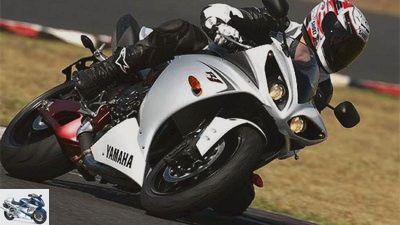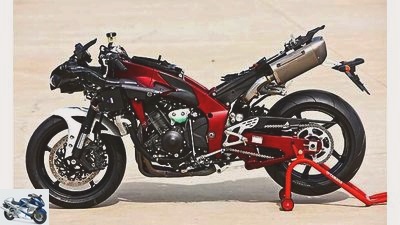Table of contents

Yamaha
motorcycles
Super athlete
Yamaha YZF-R1
Yamaha YZF-R1
A new kind of V4 experience
Japan’s four-cylinder technology seemed set in stone. But now Yamaha is stepping out of line, teaching the R1 row four V4 manners. A new, very amazing experience.
Stefan Kaschel
29/01/2009
Whether it is due to the extremely high temperatures around Sydney or the tension is not entirely clear. Anyway, Oliver Grill, Yamaha product planner from the European headquarters in Amsterdam, are beads of sweat on your forehead ?? It was a very, very long road. And until the end you can never be sure whether and how it really works. The product planning is, so to speak, the initial spark for every new project. With the new R1 it was a big bang. ?? This crank pin offset, this firing order cost top performance. You can only achieve something like this if you say goodbye to the competitive race. Drivability was the topic. We had the impression that the customers realized that more and more performance is no longer helping.”
Before the fans stare at the ground and the opponents rejoice: The result of this consideration does not exactly collapse with weakness. The new R1 has a nominal output of 182 hp. Much more important, however: it comes up with a crank pin and ignition offset that has never been seen in the long history of the Japanese inline four-cylinder. 90 instead of 180 degrees, irregular instead of regular firing order. But a lot has been written about it. About how it sounds and feels, not yet. In that magical moment when the engine comes to life, one cannot believe it. A few moments later, at the pit exit, the mouth is still open. Yes, even after the first few corners on the tricky Eastern Creek racetrack, many will still shake their helmeted heads in disbelief.
V4. A flawless V4. And what a. At least that’s what it feels like. Not even an expert would guess on a four in a row at a blind tasting. No whispering in the speed cellar, no screeching in the speed sky when the now even shorter-stroke engine (78 instead of 77 millimeters bore) screws itself with impressive commitment towards the limiter (according to the tachometer, beyond 14,000 rpm). Instead, a growl at first when the chain dog is on the leash and hits razor-sharp with every thrust of the gas. Then, once let go, a long-lasting rumble in the middle, before the backdrop in the five-digit speed range changes to a full-blown thunderstorm that attacks the rear wheel with force.
Excellence
Not enough top performance? Nobody will think about that on this side of national championships. Also clear: It cannot be as low in vibration as with a 180 degree crank pin offset, despite an additional balancer shaft. This V4, which is not one, packs more shirt-sleeved than its conventional comrades. And stronger. And very finely controllable. At least subjectively, measured against the somewhat cautious predecessor, especially in the lower and middle speed range. And that, although the Yamaha invention par excellence, the Exup exhaust control, is secretly sacrificed to the red pen. “Due to technical developments, we no longer need them,” says Oliver Grill. In addition to state-of-the-art injection electronics, two injection nozzles and variable intake snorkels, this means in particular the computer-controlled throttle valves, which always hit the optimum opening angle. The new R1 has another option: depending on which mode (standard, A, B) is selected via the right handlebar switch, the control unit interprets the respective throttle position more aggressively (A) or more defensively (B) and selects the corresponding throttle valve opening. With the result that the four-cylinder literally jumps on the gas? or at first noticeably holding back. Depending on.
In Eastern Creek, at 45 degrees, the standard setting proves to be optimal. Razor-sharp along the tire grip limit of the Michelin Pilot Power, which is usually known as grippy (now with 55 mm cross-section), which starts very early under these conditions. Has in the afternoon Yamaha a look, puts the even more manageable R1 (five millimeters less wheelbase, engine eight millimeters further forward, with the driver positioned further forward) on the brand new Michelin Power One racing rubber, adapts the setup. This makes the new R1 experience perfect. With impressive precision, the 1000 mm files along the ideal line, which is not easy to find here, steers lightly and precisely, brakes stably and with fine feedback. Growls, growls and thunders from the narrow corners and thunders like lightning over the start-finish straight. Not only delivers a new inline four-cylinder experience, but also the expected superbike qualities at the highest level. What if you could still wish for something? The famous Honda steering damper, because on the hilltops of Eastern Creek the steering head can be heard. And a lower price. A good 15,000 euros is a pound in times of tight budgets. With all the enthusiasm for the new R1 world.
Technical data Yamaha YZF-R1

Yamaha
R1, born in 2009: The engine is nine degrees steeper and sits over eight millimeters further forward. The frame and swingarm are new, as is the 43 fork. Rebound and compression damping are separated in the bars. The new one weighs four kilograms less.
engine
Water-cooled four-cylinder in-line engine, a balance shaft, two overhead, chain-driven camshafts, four valves per cylinder, bucket tappets, wet sump lubrication, injection, Ø 45 mm, regulated catalytic converter, alternator 462 W, battery 12 V / 8.6 Ah, mechanically operated multi-disc Oil bath clutch (anti-hopping), six-speed gearbox, O-ring chain, secondary ratio 47:17.
Bore x stroke 78.0 x 52.2 mm
Cubic capacity 998 cm³
Compression ratio 12.7: 1
Rated output 133.9 kW (182 hp) at 12500 rpm
Max. Torque 116 Nm at 10000 rpm
landing gear
Bridge frame made of aluminum, upside-down fork, Ø 43 mm, steering damper, adjustable spring base, rebound and compression damping, two-arm swing arm, central spring strut with lever system, adjustable spring base, rebound and compression damping, double disc brake at the front, Ø 310 mm, six-piston fixed caliper, disc brake rear, Ø 220 mm, single-piston floating caliper.
Cast aluminum wheels 3.50 x 17; 6.00 x 17
Tires 120/70 ZR 17; 190/55 ZR 17
Dimensions + weights
Wheelbase 1415 mm, steering head angle 66.0 degrees, caster 102 mm, spring travel f / r 120/120 mm, seat height 835 mm, weight with a full tank of 206 kg, tank capacity 18.0 liters.
Warranty two years
Service intervals 10000 km
Colors white, blue, black
Price including additional costs 15095 euros
Related articles
-
fact motorcycles Comparison test: Honda CBR 600 RR, Kawasaki ZX-6R, Suzuki GSX-R 600, Triumph Daytona 675, Yamaha YZF-R6 Comparison test: Honda CBR 600…
-
Premiere Yamaha YZF-R1 + videos
Yamaha 33 pictures Yamaha 1/33 First of all, we will take a look at the device: The variant with a red painted frame looks particularly elegant. Yamaha…
-
Yamaha 37 pictures Yamaha 1/37 First look at the device from all sides… Yamaha 2/37 Yamaha 3/37 Yamaha 4/37 Yamaha 5/37 Yamaha 6/37 Yamaha 7/37 What is…
-
Comparison test Yamaha FZS 1000 Fazer-R1 and Honda Hornet S-CBR 600 F
Jahn motorcycles Super athlete Comparison test Yamaha FZS 1000 Fazer / R1 and Honda Hornet S / CBR 600 F Comparison test Yamaha FZS 1000 Fazer / R1 and…
-
Comparison test between Suzuki DL 1000 V-Strom and Yamaha TDM 900
Artist motorcycles Comparison test between Suzuki DL 1000 V-Strom and Yamaha TDM 900 Comparison test between Suzuki DL 1000 V-Strom and Yamaha TDM 900…
-
Buy used Yamaha YZF-R6 properly
manufacturer counselor Used purchase Buy used Yamaha YZF-R6 properly Second hand advice Yamaha YZF-R6 (2003 – 2011) Sportiness and suitability for…
-
Comparison test Honda CBF 125 against Yamaha YBR 125
fact motorcycles Comparison test Honda CBF 125 against Yamaha YBR 125 Comparison test Honda CBF 125 against Yamaha YBR 125 Inexpensive 125cc singles No…
-
Comparison test BMW K 1300 R, Buell 1125 CR, Suzuki B-King, Yamaha Vmax
K 37 pictures Yamaha 1/37 First look at the device from all sides… Yamaha 2/37 Yamaha 3/37 Yamaha 4/37 Yamaha 5/37 Yamaha 6/37 Yamaha 7/37 What is…
-
motorcycles Driving report Yamaha TDM 850 Driving report Yamaha TDM 850 Either way Sometimes a tourer, sometimes an athlete. In recent years, many…
-
Development history of the Yamaha BT 1100 Bulldog
motorcycles Development history of the Yamaha BT 1100 Bulldog Development history of the Yamaha BT 1100 Bulldog A fat dog Truly exclusive, this pleasure:…